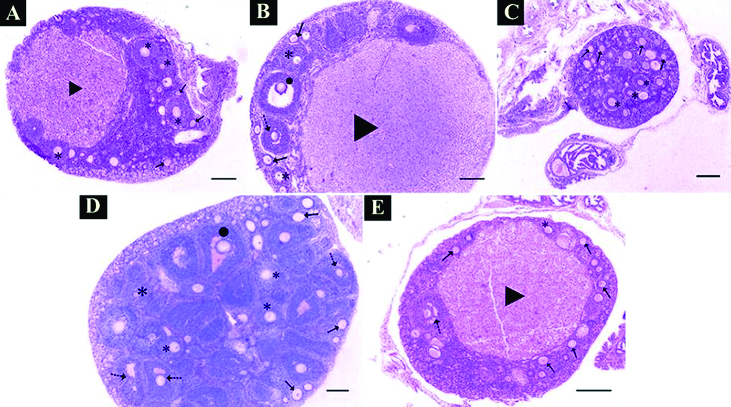ABSTRACT:
This study aimed to analyze the reproductive stage, histology and morphometry of the ovary of Dermanura cinerea in an Atlantic Forest fragments in the Biological Reserve of Saltinho, Pernambuco, Brazil. Adult females were captured monthly by mist net, during two consecutive nights from June/2014 to November/2015. The meteorological data were provided by the National Institute of Meteorology and grouped together with the reproductive data, in six periods: period I (June to August/2014), period II (September to November/2014), period III (December/2014 to February/2015), period IV (March to May/2015), period V (June to August/2015) and period VI (September to November/2015). The females were classified according to their reproductive stages in: Inactive, pregnant, lactating and postlactating. Among the 25 females caught, 10 inactive females were selected for the histomorphometric analysis of the ovaries and then they were euthanized. After that, the specimens had their ovaries removed, fixed, processed and included in Paraplast. The organs were cut and stained by Hematoxylin - Eosin and the histological slides produced were submitted to the appropriate optical microscope analysis. Each type of ovarian follicle was estimated according to the histological characteristics evidenced for other mammals. In the morphometric analysis, it was considered: The area of the ovary (measured in square millimeter), Quantification of different types of ovarian follicles (unilaminar and multilaminar primary follicles, antral and matures) and corpus luteum, as well as the area of each by those different follicles (measured in square micrometer) The results indicated that 16 females were inactive, 5 were lactating, 4 were pregnant and no post-lactating. The histological analysis revealed that the ovaries of D. cinerea exhibit characteristics, structures and cellular types similar to other mammals. The morphometric data of the study area were statistically evaluated using the Student’s t-test. Therefore, ovarian histomorphometric analysis are very important to infer with greater certainty about the reproduction of a species. Thus, it was observed that females of D. cinerea exhibit two reproductive peaks, that is, they can give birth either at the end of dry periods or from the beginning to the middle of the rainy season. The main feature observed in the ovary of this species, found in the Atlantic Forest area of the state of Pernambuco, is the preparation of the ovarian cortex to ovulate in months of high rainfall throughout the year. Therefore, this species tries to adjust its reproductive period with the variations of the environmental conditions, so that the reproduction might occur during the period more favorable for the maintenance of their offspring.
INDEX TERMS:
Reproductive stage; ovarian histomorphometry; Dermanura cinerea; Chiroptera; Phyllostomidae; Atlantic Forest; Pernambuco; bat; bimodal polyestry; ovary

 Thumbnail
Thumbnail
 Thumbnail
Thumbnail
 Thumbnail
Thumbnail


